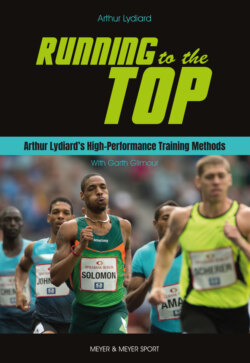Читать книгу Running to the Top - Arthur Lydiard - Страница 8
На сайте Литреса книга снята с продажи.
CHAPTER 1 THE 21 FACTORS
ОглавлениеTwenty-one factors influence the running athlete. Some are factual, some physical, the rest mental. All of them play a part in how well an athlete performs, how successfully he or she can reach whatever level of achievement he or she aspires to.
They are:
1.The date of the race
2.The challenge the race represents
3.Age
4.Talent
5.Health
6.Nutrition
7.Drugs
8.Hormones
9.Body build
10.Running technique
11.Aerobic capacity
12.Weight
13.Body fat
14.Training methods
15.Coaching
16.Tactics
17.Self-discipline
18.Track conditions
19.State of the weather
20.The opposition
21.The balance between aerobic and anaerobic exercise
Some of them appear under more than one heading. For instance, your weight and body fat at any given time are facts but they are also physical conditions which can be altered. And there are some physical conditions which are susceptible to mental influences or can influence mental attitudes. Each is an integral part of the whole athlete and his or her personal encyclopedia of knowledge.
We have not given them any order of priority because none exists but, perhaps, the single most important factor of them all is the first listed – the date of the competition.
Think about it. You do not have to be an Einstein to see how significant that race date is. Whether the race is a club championship, a national title event or an Olympic Games final, everything that happens in the lead-up to it – and we’re talking from weeks to years depending on the individual athlete’s level of experience and ambition – is aimed at that single event. Anything else along the way is merely a stepping stone to the ultimate goal.
So, everything the athlete does in that lead-up has to be timed correctly and precisely to produce the peak performance when the starting gun sounds on the big day. If you doubt that, listen to any group of athletes talking after a championship.
They are noted for their excuses after events. A lot of Olympic titles were won in times that very many competitors had comfortably bettered. Yet, on the day, they cannot perform anywhere near their best.
This demonstrates that the race date is indeed the key to correct training. I often tell young people, “Look, last year, you ran the best race of your career. Everything went right and you performed at your very best. Now, if you know why that happened and you put your training plan together properly to reproduce that peak performance again on the day of the first race you want to win this season, then I would say you know something about training.
“Until you can do that, you don’t know a damn thing about it. You are just a good athlete who, one day, without realising why it is happening, will run a good race.“
I often refer back to Lasse Viren, who, after his first Olympic triumphs, was injured and out of running for a couple of seasons but then came back as great as before. The American accused him of blood-doping, which was ridiculous. The reason was simply that I had taught the Finns how to construct a programme and follow it to achieve peaks when they wanted them – and the Finns had listened and learned. Viren knew the programme that got him his first Olympic medal; all he had to do to win some more was repeat it.
Many of the medal winners in the Olympics are not the best athletes but they are the best-prepared athletes on the day of competition. I cannot emphasise this strongly enough: A world of difference lies between the two.
So that, fairly succinctly, is what this book is all about: Guiding you to get all those 21 elements together in the right place at the right time for you to attain your selected goals in athletics.
Let’s begin by considering why running is for everyone – from potential Olympic champion to the woman or man, girl or boy who merely wants to get that extra enjoyment and satisfaction out of life that spring from simple physical and mental fitness.
